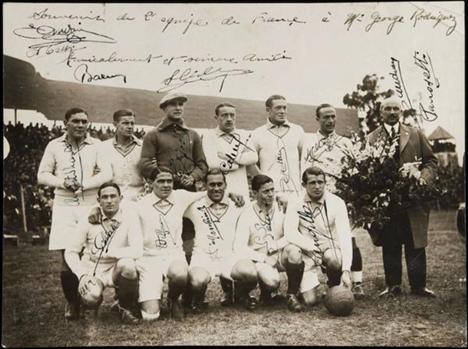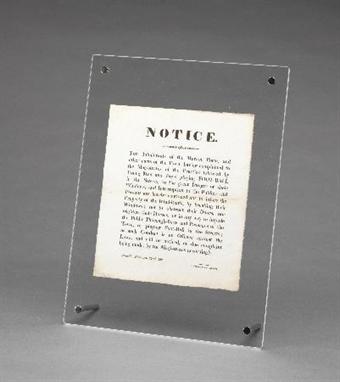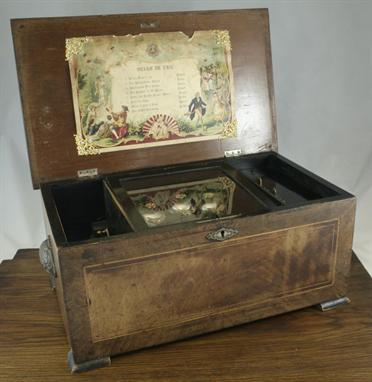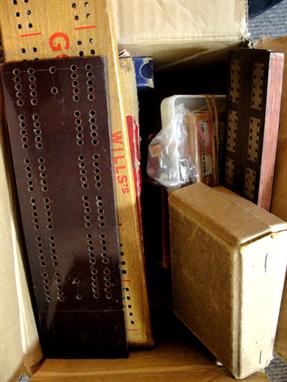We found 79736 price guide item(s) matching your search
There are 79736 lots that match your search criteria. Subscribe now to get instant access to the full price guide service.
Click here to subscribe- List
- Grid
-
79736 item(s)/page
* Scrap albums. An early nineteenth century scrap album, approx. 100 leaves, with numerous engraved views, caricatures, costumes, etc., and a number of original pencil drawings and watercolours, incl. a rare allegorical eng. map `Oxford in Epitome’, 1st ed., printed by W. Baxter for J. Vincent, near Brasenose College, 1819, 232 x 238mm (9 x 9.25ins), with accompanying letterpress key leaf mounted on opposite page; a rare suite of four hand-col. aquatint plts. by John Augustus Atkinson, entitled `The Miser’, `The Virtuoso’, `The Poet’, `The Hypochondriac’, trimmed to edge of image, approx. 220 x 165mm (8.75 x 6.5ins), c.1819; four litho. cartoon-style engs. showing two figures engaged in a game of chess (cut out from a single sheet), entitled `The Challenge - Which hand, right or left?’, `The Struggle - Intense Anxiety’, `The Victory - Check-Mate!’, `The Parting - Triumph & Chagrin’, Vincent Brooks, Day & Son; two watercolours of transforming playing cards, and two cut-out watercolours of card players in a tavern; two small finely executed moonlit seascapes by Galpin; two small costume watercolours entitled `Villageoise de Fribourg’ and `Neufchatel’; several hand-col. cut-out eng. costume plts. (mainly Turkish); hand-col. engs. of Brighton Pavilion, Ripon Minster and Warwick Castle; and two hand-col. cartoon-style engs. from `Life in London’, pub. 1822, by S. Fores, orig. red half roan, rubbed and worn, with spine deficient and upper cover detached, folio, together with another, smaller, scrap album similar, containing pencil drawings, pen & ink sketches, eng. views, eng. costumes, etc., incl. a hand-col. etched plt. of Turkish jesters (with 2Ó closed tear in upper margin), late 18th c., with engravers initials `J.D.H.’ after `B. de G.’, numbered 25 in top left corner, from a collection entitled `Recueil des Vues et Habbillemens en Turquie’, 244 x 164mm (9.5 x 6.5ins), plus seventeen other albums, 19th and 20th c., incl. several crest and monogram albums, albums of chromo. scraps and greetings cards, a photograph album, etc. (19)
Wragg (Jacob). Eighteenth Edition of Wragg’s Improved Flute Preceptor, or the whole Art of playing the German Flute: Rendered perfectly easy to every Capacity. On Principles entirely New... To which are added, A Set of Progressive Lessons, Sixty four Original Duets... & ample Instructions for an Eight Key’d Flute, op. 6, pub. Clementi Collard and Collard, c.1820s, eng. title-page (foxed and stained), 4pp. prelims., and 72pp. engraved musical notation, some finger-soiling, upper hinge split, contemp. half roan, rubbed and scuffed, extrems. worn and spine with sl. loss, slim folio (1)
A late 19th Century Swiss Music Box, 2974, playing twelve airs, the rosewood, kingwood, boxwood and ebonised case with hinged cover decorated with painted classical trophy and panelled base with side carry handles, to a further ebonised interior and tune sheet, for “Wedding March, Carmen and The Shop Girl”, to a glazed panel enclosing a 13” pin barrel with side handle, width 25 ½”
A late 19th Century Rose and Boxwood inlaid and ebonised Music Box, 34049, the hinged cover with ebonised borders and boxwood strung panel, enclosing classical musical trophies and simulated rosewood base with further transferred decoration, to an ebonised interior (lacking tune sheet), to a glazed section enclosing a 9 ¼” pin barrel playing twelve airs, with side handle, width 23”
A gold & enamel Staffordshire F.A. Senior Cup winner’s medal awarded to West Bromwich Albion’s Albert Aldridge in 1887, inscribed STAFFORDSHIRE FOOTBALL ASSOCIATION 1887, WEST BROMWICH ALBION F.C., A. ALLDRIDGE [SIC]. Albert Aldridge was born in Walsall on 13th April, 1864. The right-back joined West Bromwich Albion from Walsall Swifts in 1887. He was a member of West Brom’s 1888 F.A. Cup winning team and won two England international caps. Aldridge joined Walsall Town in July 1888, and a season later switched to Aston Villa. Tragically after playing only 14 times for Villa he was forced to retire through poor health and died aged just 27 in May 1891
Ernie Blenkinsop’s red England v Wales international cap season 1930-31, with gilt-wire English rose and inscribed 1930-31, in very good condition; sold with a signed statement of provenance (2). This match was played at The Racecourse, Wrexham, on 22nd November 1930. England won the game 4-0. Sheffield Wednesday’s left-back Ernest Blenkinsop won a total of 26 England caps between 1928 and 1933. A contemporary commentator described him as ‘a back of polish and style, coolness in tackling, and a placer of kicks.’ Blenkinsop also helped Wednesday win back-to-back Championships in 1929 and 1930 . Provenance:. The Collection of Allen Wade, Director of Coaching, Football Association, 1963-1982. In his playing days, Allen Wade was a team-mate of Ernie Blenkinsop’s son Barry at Notts County who gave Allen Wade the cap. The lot includes a signed statement of provenance from Allen Wade.
Danny Blanchflower’s Tottenham Hotspur 1962 F.A. Cup winner’s medal, a 9ct.gold medal inscribed 1961-62, THE FOOTBALL ASSOCIATION, CHALLENGE CUP, WINNERS, TOTTENHAM HOTSPUR F.C., D. BLANCHFLOWER, now within a later pierced scrolling frame with suspension loop. Born in Belfast on 10th February 1926, Robert Dennis “Danny” Blanchflower played football for Connsbrook and Bloomfield United before joining Glentoran in December 1945. He joined Barnsley in 1949 for £6,500 and played four times for Northern Ireland before joining Aston Villa in a £15,000 move in March 1951. Whilst with Villa he played a further nine times for Northern Ireland before joining Tottenham Hotspur in December 1954 for £30,000. It was with Spurs that he had major success both at Club and International level. As captain for his national side as well as Spurs, he became one of the most influential and respected players of his generation. In 1958 he was awarded his first Footballer of the Year trophy and led Tottenham Hotspur to their “Double” win in season 1960-61 and a further F.A.Cup win in 1962, for which the present medal was presented. His club playing career culminated in the European Cup-Winners’ Cup win in 1963, with Spurs becoming the first British side to win a European trophy. In a ten year period with Spurs he made a total of 436 appearances, scoring 27 goals, including the third goal in the F.A.Cup final of 1962. He also captained Northern Ireland in their successful 1958 World Cup campaign and played a total of 56 times for his country. He retired from playing football on 30th June 1964 and had a successful career in journalism before returning to football as Chelsea manager in December 1978. He stayed with Chelsea in this capacity until September 1979 before becoming Northern Ireland manager. In the 1962 F.A. Cup final Danny Blanchflower captained Tottenham Hotspur to their second successive Cup final win. The match was played at Wembley on 5th May 1962 with Spurs defeating Burnley 3-1. Blanchflower scored his side’s third and decisive goal from the penalty-spot in the 80th minute.
Nick Barmby’s bronze prize medal and playing shirt from the 1993 FIFA World Youth Championships in Australia, the FIFA bronze medal suspended from green & gold ribbon and mounted together with Nick Barmby’s white No.9 long-sleeved jersey inscribed beneath the ‘three lions’ badge WORLD YOUTH CHAMPIONSHIPS, AUSTRALIA 1993, framed, glazed and titled NICK BARMBY, 72.5 by 87.5cm., 28 1/2 by 34 1/2in
The following five lots are jerseys that Denis Law gained as swaps between 1962 and 1966. They are being offered by the grandson of Denis Law’s landlady during his playing days in Manchester, firstly when playing for City in season 1960-61, and thereafter when he returned as a United player after the season at Torino.. When eventually moved on from his lodgings, Denis Law left the jerseys for the vendor’s grandparents to keep. Some further Denis Law jerseys from this same collection are currently on loan and display at the Manchester United Museum, Old Trafford, including Denis Law’s 1963 F.A. Cup final jersey. Sammy McMillan: the green Northern Ireland No.8 jersey worn in the match v Scotland at Hampden Park 7th November 1962, short-sleeved, square I.F.A. cloth badge, gained as a swap by Denis Law from his Manchester United team-mate at the end of the game. This was an unhappy night for the Irish, with Scotland winning the game convincingly 5-1. Enquires made in regard to this Sammy McMillan jersey revealed that Mr McMillan is still in possession of Denis Law’s Scotland jersey that he exchanged for his own at the end of the 1962 international
An exceptional collection of 1966 World Cup autographs: in the form of an album of first day covers signed by all 16 competing national squads, compiled by the noted Glasgow football memorabilia collector Ronald Antinoris during the course of the tournament, a World Cup Collectors Club photographs album with blue cloth covers, gilt, containing a series of sixteen 6 by 8in. b&w photographs of the World Cup teams laid down on the left-hand page, while to the opposing side is a series of commemorative first day cover bearing World Cup postage stamps postmarked 1 Jun 66 autographed neatly and uniformly in fountain pen using black ink by the World Cup playing squads, the only exception being the England 22 which has been signed over a pair of postal covers,the accompanying photograph being on the preceding and first right-hand page of the album, the running order after England being alphabetical, namely Argentina, Brazil, Bulgaria, Chile, France, Germany, Hungary, Italy, Mexico, North Korea, Portugal, Russia, Spain, Switzerland & Uruguay, the completeness of the squad signatures was down to the availability of the players on the given day Mr Antinoris sought their autographs, and consequently on some occasions one or two of the squad members are not . Represented in the collection, but the overwhelming majority of the 352 international footballers who participated in the tournament are represented in this superb collection
A 1990 FIFA World Cup runners-up medal, in continental silver by Huguenin, the obverse with the World Cup Trophy in raised relief, the reverse inscribed COUPE DU MONDE DE LA FIFA ITALIE 1990, suspended by medal ribbon in the . Colours of the Italian national flag; sold with a COA (2). This medal was awarded to the Argentinian goalkeeper Nery Alberto Pumpido who began the 1990 World Cup tournament as first-choice goalkeeper. However, tragedy struck and he broke a leg in Argentina’s second game against Russia. In a demonstration of the fickle nature of professional sport, Pumpido’s absence paved the way for his replacement Sergio Goycochea to become a national hero after playing crucial parts in two penalty shoot outs that helped the South Americans reach the final. Ironically, West Germany won the final through a penalty kick five minutes from time.
A fully signed b&w photograph of the France team before the very first match in World Cup finals history v Mexico at the Pocitos Stadium, Montevideo, 13th July 1930, the 7 by 9 1/2in. photograph fully signed in ink by the starting XI Thepot, Mattler, Capelle, Villaplane (captain), Pinel, Chantrel, Liberati, Delfour, Maschinot, Laurent and Langillerand, plus the head coach Raoul Caudron, and bearing further signatures, presumably reserves.It was appropriate that the dream of World Cup founders Henri Delaunay and Jules Rimet got underway with France having the honour of playing in the first-ever World Cup game. France won the match 4-1. A similar picture, but taken from a slightly different angle, is in the Getty Images Archive, ref: 88616812. £200-300
A highly important cuttings album containing what is believed to be the oldest surviving item of Newton Heath and therefore Manchester United memorabilia and additionally the autographs of The Outcasts FC a group of rebel players who paved the way for the formation of the Players Union, and the current P.F.A., Containing:. I) a pasted leaf with the 10 signatures of Newton Heath LYR, believed to have been signed on the occasion of the match v. the Canadian touring team on 6th October 1888, with the missing signature from the line up being the right winger William Tait. Believed to be the oldest surviving item of . Newton Heath and therefore Manchester United memorabilia. A programme for Everton v. Newton Heath on April 15th, 1889 is understood to be in the David France Everton Collection Charitable Trust;. Ii) a team-group leaf titled Manchester United 1908-09 & 1910-11, 14 signatures. Iii) the autograph of Billy Meredith, the signature dated Feb 12/07;. Iv) Ernest Mangnall’s signed official Manchester United team-sheet for the 1909 F.A. Cup final v Bristol City at The Crystal Palace, Manchester United’s historic first appearance and win in the Cup final;. V) a leaf containing team-group signatures of The Outcasts F.C inscribed “Playing for union rights”, The Outcasts being a group of rebel players captained by United’s Charlie Roberts and team-mate Billy Meredith, also signed by the United goalkeeper Herbert Broomfield, inscribed Players Union Secretary, the autograph set almost certainly relating from the same day that the famous photograph was taken of the Outcasts at Fallowfield in July, 1909 (this photo is reproduced in the John Harding book “For the Good of the Game” which contains an introduction by Gordon Taylor of the PFA), the only missing signature from the photograph being that of Turnbull, other signatories include Moger, Duckworth, Wall, Corbett, Picken, Holden, Coleman, Clough, Burgess and G. Boswell (PU asst. Secretary);. Vi) an envelope addressed to A H Albut, [first] Secretary of Newton Heath Football Club, at the club’s first office, 33 Oldham Road; & another envelope addressed to James West, a later Club Secretary at Bank Street . Vii) the album also containing the signatures of other footballers of the Edwardian era, mostly signed over printed biographical newspaper articles, comprising Robert Hawkes (Luton), Robert Smith Robinson ( Liverpool), Peter Kyle (Spurs), Alec Raisbeck (Newcastle), Harry Thorpe (Fulham), Thomas Riley (Brentford), Arthur Collins (Fulham), H Robinson (Birmingham), J T Robertson (Chelsea), David Ross (Norwich), & J S Fryer (Fulham). Viii) the album also containing press cuttings & non- football related family scraps. Provenance:. Emma Gaskell of the Gaskell family of Knutsford, Cheshire. Emma Gaskell being the god-daughter of James West, the Club Secretary of Newton Heath, becoming Manchester United in 1902. Thence by family descent
An unusual collection of programme relating to the playing days of Corporal A. Jackson of R.A.C. Bovington dating between 1948 and 1950, including programmes for the 1947-48 Army Football Association Cup semi-final, final and replay; other Army Cup semi-final and final programmes and other games concerning a team from Bovington, including the 1949 Dorset County F.A. Cup final v Bridport and matches played at Poole Town, Portland United & Weymouth; together with programmes for A. Jackson’s appearances for Bournemouth Gas Works, and several appearance for the Dorset County F.A. in the Southern Counties Amateur Championship including a match played at Bristol City 24.1.48, some duplication; together with player’s passes and tickets including a wartime international between Poland & Great Britain played in Baghdad 24.1.1943, Army Cup finals & Semi-finals and a for Redhill FC. Tragically, during the 1948 Army Cup final played at the Command Central Ground in Aldershot, two players were killed by lightning and many other players and spectators left injured. The match was duly abandoned and the two teams were declared joint-winners. A medals collection relating to the amateur football career of Corporal A. Jackson is offered elsewhere in the auction as lot 10.
A rare, historically interesting and apparently previously unrecorded public notice served by the Magistrates of Alnwick in Northumberland in 1821 cautioning inhabitants that the playing of football in the streets is an offence against the laws, printed by J. Graham, Alnwick, dated February 22nd 1821, and reading: THE INHABITANTS OF THE MARKET PLACE, AND OTHER PARTS OF THE TOWN, HAVING COMPLAINED TO THE MAGISTRATES OF THE PRACTICE FOLLOWED BY YOUNG MEN AND BOYS PLAYING FOOT-BALL IN THE STREETS, TO THE GREAT DANGER OF THEIR WINDOWS, AND INTERRUPTION TO THE PUBLIC. ALL PERSONS ARE HEREBY CAUTIONED NOT TO INJURE THE PROPERTY OF THE INHABITANTS, BY BREAKING THEIR WINDOWS; NOR TO OBSTRUCT THEIR DOORS, NOR FRIGHTEN THEIR HORSES, OR IN ANY WAY TO IMPEDE THE PUBLIC THOROUGH-FARES AND PASSAGES OF THE TOWN, BY PLAYING FOOT-BALL IN THE STREETS; AS SUCH CONDUCT IS AN OFFENCE AGAINST THE LAWS, AND WILL BE NOTICED, ON DUE COMPLAINT BEING MADE, BY THE MAGISTRATES ACCORDINGLY. Alnwick hosts Northumberland’s sole surviving Shrovetide game of festival football which was first recorded there in 1788. but with local legend dating it even earlier to 1762. Opposition to mass football on Shrove Tuesday because of damage to property in Alnwick town, and disruption to traffic on the main road leading north through Alnwick to Scotland, led to the Alnwick Improvement Act of 1822. This prohibited the street games of bull-baiting, cock-throwing, bonfires and football. The ban was not enforced, however, until after the 1827 Shrove Tuesday game when its patron The Duke of Northumberland, who had paid for the damages caused by the footballers, received a petition from residents demanding action, so His Grace consented to the future use of pasture land outside the town. A year later on the 16th February 1828, three days before Shrove Tuesday, the Magistrates cautioned that anyone playing football in the streets would be fined. The ‘Notice’ offered in this lot, dated seven years earlier, 22nd February 1821, gives the Magistrates few, if any, real powers or remedies. It is reasonable to conclude this is why the Improvement Act was introduced a year later. Most importantly, however, the 1821 notice gives clear evidence football had already been played in the streets of Alnwick at least twelve days before Shrove Tuesday which, in 1821, did not fall until the 6th March. Therefore, it was not only a festival game played at Shrovetide. The practice of football in Alnwick was more widespread. Furthermore, the Notice did not, despite the opportunity to do so, ban the playing of football in the streets on Shrove Tuesday less than two weeks away. Provenance:. Archive of former Solicitors’ to Dukes of Northumberland. Literature:. With grateful acknowledgement to Hugh Hornby for his extensive chapter on the history of Shrovetide football in Alnwick, p.92-97, Uppies and Downies: The Extraordinary Football Games of Britain, published by English Heritage, 2008
A 16mm film “Little Miss Poker Face” the career of Helen Wills Moody Roarke, 12 minutes duration, in can; the film has been copied to DVD and is offered in the lot (2) The film commences with action shots of her first final at Forest Hills in 1923 when 17 year old Wills beat Molla Mallory the defending Champion. We see footage of both players rallying during the match. We follow Wills to Wimbledon in 1924 the kings of Spain and Portugal looking on from the Royal Box. The commentator then lists the Championships that Wills had won during her career while we see fine slow-motion footage. There is superb extensive footage of the famous Wills v Lenglen encounter at Cannes in 1926, their only singles meeting, with Lenglen succeeding in two closely fought sets. We see huge crowds, cameramen and many rallies taken during the match. Close-ups of both ladies are shown and huge bouquets of flowers are presented at the conclusion. Victorious American Wightman Cup players are shown and then we meet Helen Jacobs in close-up. Molla Mallory and Spain’s Lili D’Alvarez follow with some film of Wills playing exhibition matches against Vini Richards, Bill Tilden and Rene Lacoste. Footage from 1929 is accompanied by commentary on why she received her ‘nickname’. We see her outside the church following her marriage to Fred Moody (Close-ups). And then Helen in her studio with her paintings, and brushes being stored inside her trophies! We see her outside Buckingham Palace, having been presented to the King and Queen. Again her victories are listed. We see her with The Bishop of London, King Gustav of Sweden, Japan’s Tamio Abe, and once again against Helen Jacobs at Forest Hills. We see her on the ocean liner en-route to England for the Wimbledon Championships of 1935. We see the groundsmen preparing the hallowed courts. We see general ground shots at Wimbledon and then Wills and Jacobs meeting in the final
Golf ephemera, comprising: 5 packs of New Golf playing cards; 2 packs of New Kargo Golf playing cards; two 8mm home movies, Teeing Off and Putting by Sam Snead; a dice golf game; a golf game puzzle; Bobby Jones Flicka Bok No. 11a Drive and Mashie; and a parachute golf ball in original box (13)
A Swiss (Geneva) Comb and Cylinder Musical Box, the 11in cylinder playing eight airs as named on the original lozenge shape lithograph tune sheet underneath the lid with inscription Fabrique de Geneve Spiraux Metalliques, numbered 37725 (on tune sheet and on winding handle), in a part rosewood foliate marquetry inlaid case, 51cm wide
A Jaques "The Staunton Chess-Men" Set, red and natural ivory, numbered 1171, entered no.3366, in original Carton Pierre box and contemporary Carton Pierre mounted playing board by Leuchars, circa 1860, some pieces stamped with a crown, the natural king stamped underneath the base Jaques London, 9cm high, the folding board with red and white gilt tooled playing surface stamped Leuchars, 53cm wide (open)
A 19th century Sèvres style porcelain coffee cup and saucer the central panel decorated with two putti playing with flowers within a green border with gilt highlights, printed marks, cup 6cm high, saucer 12cm diameter; a Frankenthal style cup and saucer, the central panel decorated with a bird on a branch surrounded by puce painted flowers, underglaze blue mark to base, cup 7.5cm high, saucer 12.5cm diameter; and an English porcelain mug decorated with flowers and inscribed in gilt `Margaret Williamson/ 1877`, 9cm high (5) Provenance: The collection of Samuel Johnston Melvin, Paisley and thence by descent to the present owner.
Football: C.I.S. v England 29 April 1992, programme, entry ticket and photographers bib with CIS Logo. At this time Russia were playing as the Combined International States and this was the only game that England played against this side. Formally the property of Albert Cooper of the Daily Mirror. (vg) (3)
Cigarette & trade cards: Selection, with cards in vintage slot-in albums, trade issues, postcards (Cats & Dogs), Player`s Playing cards, a large quantity of cartophilic magazines & literature, 1938 onwards, numerous editions of Cigarette Card News and others plus auction catalogues, reference books etc (qty, a boxes)
-
79736 item(s)/page














































